Paradyne Hotwire 5446 Specification
- Category
- Networking
- Type
- Specification

TM
1
Hotwire 5446 RTU Customer Premises
Installation Instructions
Document Number 5446-A2-GN10-50
October 1998
Before You Begin
The Hotwire 5446 RTU (Remote Termination Unit) interoperates with the Hotwire
8546 DSL Card in the DSLAM system.
An optional POTS (Plain Old Telephone Service) splitter is available for the Hotwire
5446 RTU. When a POTS splitter is installed, the telephone and 5446 RADSL (Rate
Adaptive Digital Subscriber Line) RTU can function at the same time over the same pair
of copper wires. In order to confirm the RTU installation, the POTS splitter should be
installed first.
To install a POTS splitter, refer to the appropriate POTS splitter document:
Document Number Document Title
5030-A2-GN10
Hotwire 5030 POTS Splitter Customer Premises
Installation Instructions
5038-A2-GN10
Hotwire 5038 Distributed POTS Splitter Customer Premises
Installation Instructions
Contact your sales or service representative to order additional product documentation.
Paradyne documents are also available on the World Wide Web at:
http://www.paradyne.com
Select
Service & Support
→
Technical Manuals
Wiring and Cables Needed
The following wiring and standard connectors are used with this product:
New or existing unshielded twisted-pair wiring (CAT3 or better). The CAT3 wiring
must meet EIA/TIA-568 specifications with 24 AWG (.5 mm) or 26 AWG (.4 mm).
Standard RJ11 wall jack.
Standard Ethernet 8-pin, non-keyed modular plug for a PC or workstation. An
Ethernet straight-through or crossover cable is used. Refer to
Installing the Hotwire
5446 RTU,
page 8, for Ethernet cable details.
After the RTU is installed and powered on, there are additional requirements in order to
utilize the DSL and Ethernet connections. Refer to
Hotwire 5446 RTU IP Setup
,
page 16.

2
Package Checklist
Verify that your package contains the following:
-
Model 5446 Remote Termination Unit (RTU)
-
DSL interface cable with RJ11 connectors
-
Power cord with power transformer
-
Two ferrite chokes
-
Warranty card
Refer to
Cables & Connectors,
page 17, for standard pin numbers.
What Does the Hotwire 5446 RTU Do?
The Hotwire 5446 RTU is a component in the Hotwire RADSL Access System. This
system provides high-speed Internet or corporate LAN access over traditional
twisted-pair copper telephone wiring.
A POTS splitter blocks out the DSL signal and allows the POTS frequencies to pass
through. At the customer premises, the RADSL RTU and a telephone can function
simultaneously over the same pair of copper wires when either:
H A Hotwire 5030 or 5038 POTS Splitter is installed near the demarcation point for all
telephones on the same POTS line as DSL,
or
H A Hotwire 5038 Distributed POTS Filter is installed on each telephone on the same
POTS line as DSL.
DSL Access with a Hotwire 5030 or 5038 POTS Splitter
Copper pairs run from the central office (CO) to the customer premises (CP) to create
the local loop. The local loop terminates on the customer premises at the demarcation
point in a punchdown block or network interface device (NID).
The Hotwire 5030 POTS splitter is designed for outdoor or indoor installation. The
Hotwire 5038 POTS Splitter is designed for indoor use only.
When a Hotwire POTS splitter is used at both ends of the local loop, wiring is
connected:
H From the demarcation point to the CP POTS splitter, and
H From the demarcation point to the DSL jack.
NOTES:
— End-user system is used to represent any PC with an Ethernet connection and
DSL-based service.
— Network Service Provider (NSP) is used to represent any Internet Service
Provider (ISP) or remote LAN access provider.

3
98-16105
Punchdown
Block or NID
DSL
Jack
RTU
Customer Premises (CP)
DSL
Ethernet
Crossover
Cable
Ethernet
Cable
or
Central
Office
(CO)
Demarcation
Point
Local Loop
CP
POTS
Splitter
DSL – Digital Subscriber Line POTS – Plain Old Telephone Service
NID – Network Interface Device RTU – Remote Termination Unit
POTS
End-user
Systems
Network
Service
Provider
(NSP)
Hub or
Router
New Wiring Connections Existing Wiring (POTS)
DSL Access with a Hotwire 5038 Distributed POTS Splitter
When a Hotwire 5038 Distributed POTS Splitter is used, one 5038 Distributed POTS
Splitter is installed as a filter for each telephone on the same POTS line as DSL.
98-15815-01
RTU
Customer Premises (CP)
Central
Office
(CO)
Local Loop
POTS
Splitter
To End-user
Systems
DSL – Digital Subscriber Line POTS – Plain Old Telephone Service
NID – Network Interface Device RTU – Remote Termination Unit
POTS
Splitter
POTS
Splitter
Network
Service
Provider
(NSP)
Demarcation
Point
Punchdown
Block or NID
POTS/DSL
Optional

4
DSL Access without a POTS Splitter
When the Hotwire 5446 RTU is installed without a POTS splitter, a second telephone
wiring pair is needed for DSL access.
98-16104
Punchdown
Block or NID
DSL
Jack
RTU
Customer Premises (CP)
POTS
DSL
Ethernet
Crossover
Cable
Ethernet
Cable
or
Central
Office
(CO)
Demarcation
Point
Local Loop
Hub or
Router
End-user
Systems
DSL – Digital Subscriber Line POTS – Plain Old Telephone Service
NID – Network Interface Device RTU – Remote Termination Unit
Network
Service
Provider
(NSP)
New Wiring Connections Existing Wiring (POTS)

5
Installing the DSL Access Wiring
The local loop terminates at the punchdown block or NID. Wiring must be connected
from the customer premises side of the punchdown block or the NID to the DSL jack.
Typically, the punchdown block is installed in commercial locations and the NID is
installed in residential locations.
Procedure
1. Access the punchdown block or NID.
!
WARNING:
Do not continue unless the DSL access line from the local loop has been
disconnected at the NID or punchdown block. Refer to
Important Safety
Instructions,
page 19.
2. Disconnect the DSL access pair from the local loop. A punchdown block is used
without a POTS splitter in the following example.
ABCD
DSL
Access
from Local
Loop
Wiring to
DSL Jack
Bridge Clip
Punchdown Block
97-15348
Demarcation Point
Customer Premises

6
3. Locate the DSL pair of T1/R1 connectors on the customer premises side of the NID
or punchdown block. Attach the wiring that will be connected to the DSL jack. In the
following example, a NID is used without a POTS splitter. It includes an existing
POTS line and a second pair installed for DSL access.
DSL/POTS
Access from
Local Loop
Wiring to
DSL Jack
Telephone Network Interface Device (NID)
Ground
Tip
T1
(Green)
Ring
R1
(Red)
97-15438-01
Existing POTS
Wiring to
Telephone
Demarcation Point
Customer Premises
DSL Pair
POTS Pair

97-15300a
RJ11 Wall Jack
or
7
The Hotwire 5446 RTU connects to the local loop via wiring from the demarcation point
to an RJ11 wall jack. The DSL twisted-pair wiring from the local loop terminates at a
new or existing wall jack. It may be necessary to install a standard single RJ11 jack or
replace a single jack with a double RJ11 jack.
97-15343-02
DSL
RJ11
Jack
Central
Office
Punchdown
Block or NID
Customer Premises
POTS/DSL
Local Loop
Demarcation Point
DSL
Twisted-pair
Wiring
RTU
Procedure
1. Wiring can be run from the
punchdown block or NID to a
new or existing wall jack. Match
the pair colors on both ends.
2. Label the DSL jack.
3. Reconnect the DSL access pair
at the punchdown block or NID.
Refer to
Installing the DSL
Access Wiring
, page 5
.
Tighten
both terminal screws with a flat-
blade screwdriver.
The RJ11 6-pin jack uses the center two pins. For pin assignments, refer to
Cables &
Connectors
, page 17.

8
Installing the Hotwire 5446 RTU
Place the Hotwire 5446 RTU on a flat surface with clearance for the rear connectors.
Procedure
1. Use the RJ11 6-pin cable for the DSL connection. Insert one end of the cable into
the jack labeled DSL. Insert the other end into the wall jack labeled DSL.
97-15300-01
DSL
Jack
POWER
ETHERNET
DSL
Hotwire RTU
If the Hotwire 5446 RTU is installed on the same line as POTS, a Hotwire 5038
Distributed POTS Splitter can be used as a filter. One 5038 Distributed POTS
splitter is installed as a filter for each telephone, as shown below. To install the
Hotwire 5038 Distributed POTS splitter, refer to
Hotwire 5038 Distributed POTS
Splitter Customer Premises Installation Instructions.
98-15813
Distributed
POTS Splitter
Line from
RJ11 Wall Jack
PHONE
LINE DSL
PHONE
LINE DSL
PHONE
LINE DSL
Line from
RJ11 Wall Jack
Distributed
POTS Splitter
Distributed
POTS Splitter
Customer
Premises (CP)
Hotwire
RTU

9
2. Use an 8-pin Ethernet cable for the Ethernet connection. Insert one end of the
cable into the jack labeled ETHERNET.
Use a straight-through cable and connect the other end to an Ethernet hub, or
97-15303-01
Ethernet
Hub
Ethernet
Line
POWER
ETHERNET
DSL
Hotwire RTU
Ethernet
Cable
Use an Ethernet crossover cable and connect the other end to a PC with an
Ethernet Network Interface Card (NIC) or router.
97-15303b
PC with Ethernet
Network Interface
Card
Ethernet
Line
POWER
ETHERNET
DSL
Hotwire RTU
Ethernet
Cable
For RTU cable pin assignments, refer to
Cables & Connectors
, page 17.

496-14952
97-15303c
Ethernet
Line
POWER
ETHERNET
DSL
Hotwire RTU
Ferrite
Choke
10
3. Place the large ferrite choke on
the Ethernet cable as closely as
possible to the RTU. Pass the
Ethernet cable through the
ferrite choke twice, creating
a loop as shown.
4. Close the two halves
around the cable and
snap the ferrite choke
shut. Press down on the
plastic latch to secure
the ferrite choke in place
around the cable.
5. Insert the power cord’s round end into the jack labeled POWER. Attach the ferrite
choke on the power cord as closely as possible to the RTU. Pass the power cable
through the ferrite choke twice, creating a loop as shown.
97-15796
POWER
ETHERNET
DSL
Hotwire RTU
Power
Jack
or
Ferrite
Choke
6. Close the two halves around the cable and snap the ferrite choke shut. Press down
on the plastic latch to secure the ferrite choke in place around the cable.
7. Plug the transformer into an AC outlet.

11
The RTU hardware installation is now complete. When the power cord is installed, the
RTU goes through a power-on self-test.
Optional RTU Wall Placement
The Hotwire 5446 RTU is designed for tabletop placement. The RTU can also be
mounted on a wall. To mount an RTU, you will need:
-
Three slotted-head #6 self-threading screws with molly bolts
-
Drill and 3/16” drill bit for the molly bolts
-
Screwdriver
A template with the dimensions for the three screws is provided. See
RTU Hardware
Template
on page 12.
" Procedure
To mount the RTU:
1. Use a drill to install the plastic anchors (molly bolts)
2. Use a screwdriver to install the screws. Do not install the screws flush with the wall.
Leave enough clearance to hang the RTU housing from the screws.
Wall
Fasteners
98-16170
Hotwire
RTU

12
RTU Hardware Template
Front
(LEDs)
98-16171
5.43"
7.55"
To Bottom
Hole

13
Power-On
When power is applied, the RTU performs self-diagnostics and the PWR LED is on. The
self-diagnostics includes a power-on self-test. During the power-on self-test, all of the
LEDs turn on for one second.
TST
DSL
ETHERNET
ALMPWR
TM
97-15317
Power – green
Alarm – red
Test – yellow
Digital Subscriber Line – green
Ethernet Link – green
5446
Refer to
Troubleshooting,
page 14, for LED indications requiring action.
Status LEDs
All of the LEDs turn on and off during the power-on self-test. After a successful self-test,
the LEDs should appear as indicated in BOLD in the Condition column below.
LED Condition Status
PWR ON RTU has power.
ALM OFF
ON
No active alarms.
An alarm condition exists.
TST OFF
ON
No active tests.
The TST LED is on during the power-on self-test and
during a test initiated by the NSP.
DSL Fast
blinking
Slow
blinking
ON
OFF
RTU is establishing the active DSL link. The LED blinks
on and off about five times per second.
The DSL link is up and the RTU is establishing the active
PPP (Point-to-Point protocol) link. The LED blinks on and
off every two seconds.
The DSL/PPP link is ready to transmit and receive data.
The DSL link has not been established.
ETHERNET ON
OFF
The Ethernet 10BaseT connection to the Ethernet hub or
PC is active.
No Ethernet 10BaseT device is detected.

14
Troubleshooting
LED Symptom Action
All LEDs are on.
The RTU may be in download mode. Wait ten minutes.
If LEDs remain on after ten minutes and the RTU is not in
download mode, the RTU is not functional. Contact the NSP.
ALM LED remains
on.
The power-on self-test may have failed. Unplug the unit and
reapply power. If the alarm light is still on, contact the NSP.
ALM and TST
LEDs remain on.
Firmware download may be in progress. If firmware download
is not in progress or the LEDs remain on after ten minutes,
contact the NSP.
DSL LED is off. Verify that the DSL cable is securely installed on both ends.
If the problem continues, contact the NSP.
DSL LED continues
to blink after the
power-on self-test.
The RTU is attempting to establish the DSL link or is adjusting
the rate of the DSL line due to line conditions. If the DSL LED
continues to blink for more than five minutes, contact the NSP.
DSL LED is on and
there is no data
transmission.
The DSL link has been established but there is no data
transmission. Verify the Ethernet connection. If the problem
persists, contact the NSP.
DSL and Ethernet
LEDs are on and
there is no data
Verify that your IP address, subnet mask, and default gateway
have been entered correctly in the end-user system.
there is no data
transmission.
From the end-user system, use the PC Ping utility to ping the
5446 RTU’s IP address.
If no response to the ping, use the PC ARP (Address
Resolution Protocol) utility to verify the IP address and physical
address (MAC address) from the end-user system to the 5446
RTU. If the problem continues, contact the NSP.
Ethernet LED is off.
Verify that the Ethernet 10BaseT cable is securely installed at
both ends, and at least one PC is connected and powered on.
Verify that the correct straight-through or crossover cable is
installed. Refer to
Installing the Hotwire 5446 RTU,
page 8.
PWR LED is off.
Check that the power cord is securely installed on both ends.
If no LEDs are on, the power supply may be defective. Test the
outlet to verify power. If the problem persists, contact the NSP.
If other LEDs are on, the PWR LED may be burned out. Unplug
the unit and reapply power; watch all LEDs during the power-on
self-test to verify that the PWR LED is functioning.
TST LED is on. A test initiated by the NSP may be active. Wait five minutes. If
the TST LED does not go off, contact the NSP.

15
Hotwire 5446 RTU Next-Hop Router Support
The Hotwire 5446 RTU now includes support for next-hop routers and a default
gateway.
The following illustration includes a router and a default gateway. The maximum of 32
end-user systems applies to end-user systems directly connected to the 5446 RTU
(with or without a hub) and end-user systems connected to routers. Any connections to
a default gateway are not included in the 32 systems.
98-16091
Customer Premises (CP)
DSL/POTS
End-user
Systems
TST
DSL
ETHERNET
ALMPWR
TM
5446 RTU
Router
Default
Gateway
Hub Hub
Hub
End-user
Systems

16
Hotwire 5446 RTU IP Setup
The Hotwire 5446 RTU hardware installation is now complete. Additional steps are
required by the NSP to utilize the DSL and Ethernet connections.
Network Service Provider Example
The ISP:
Assigns and sets up the RTU IP address and subnet mask.
Assigns the IP address and subnet mask for each end-user system connected to
the 5446 RTU.
To configure the end-user system, the following is used:
IP address
Subnet mask
Default gateway*
* In most cases, the 5446 RTU is the upstream default gateway for all connected
end-user systems. The other option is to connect a router between the 5446 RTU
and the end-user system.
Example using TCP/IP Network Settings with Windows 95:
Set up the network configuration. Use the network settings in the Windows environment
to enter the default gateway, IP address, and subnet mask.
1. To configure the end-user system, from the Control Panel window, select:
Network
→
Configuration
→
TCP/IP
2. From the TCP/IP Properties window, select Gateway and enter the 5446 RTU’s
IP address.
3. From the IP Address
window, enter the IP Address and Subnet Mask. Select OK.
NOTE:
Any application supported by the NSP should now start up.

98-15304-01
6-Pin
RJ11 Plug
DSL
Cable
Pin #1
Pin #6
17
Increasing the Number of End-User Systems
A single end-user system is attached to the 5446 RTU by using an Ethernet crossover
cable. To increase the number of end-user systems, connect all end-user systems to an
Ethernet hub using straight-through Ethernet cables. Refer to
Installing the Hotwire
5446 RTU,
page 8.
The initial IP address for the first end-user system remains in effect when the end-user
system is reconnected. All new end-user systems must be configured by the NSP.
Coordinate additional IP addresses and subnet masks with the NSP.
The 5446 RTU can support up to 32 end-user systems using static or dynamic IP
addressing. The number of end-user systems can be increased on the network with the
use of subnets utilizing static addresses or connecting to a default gateway. Verify any
planned changes with the NSP.
Cables & Connectors
Use standard twisted-pair CAT3 or better cables.
This section is reference information.
The DSL interface connector uses a 6-pin,
non-keyed modular plug.
RJ11 6-Pin Connector
Pin # Function
1 & 2 Not used
3 DSL Ring
4 DSL Tip
5 & 6 Not used

98-16055a
8-Pin
Plug
Ethernet
Cable
Pin #1
Pin #8
18
The Ethernet interface connector uses an 8-pin, non-keyed modular plug.
— To connect to an Ethernet hub, use the straight-through connection.
8-Pin Straight-Through Connection
Pin # Function
1 10BaseT TX D+
2 10BaseT TX D–
3 10BaseT RX D+
4 & 5 Not used
6 10BaseT RX D–
7 & 8 Not used
— To connect the RTU directly to a PC with an Ethernet NIC card or a router, use
an Ethernet crossover cable.
10BaseT TX D+
10BaseT TX D–
10BaseT RX D+
Not Used
Not Used
10BaseT RX D–
Not Used
Not Used
1
2
3
4
5
6
7
8
1
2
3
4
5
6
7
8
10BaseT TX D+
10BaseT TX D–
10BaseT RX D+
Not Used
Not Used
10BaseT RX D–
Not Used
Not Used
Function Pin # FunctionPin #
8-Pin Ethernet Crossover Cable
97-15316

19
Hotwire 5446 RTU Technical Specifications
Item Specification
*
Height x Width x Depth 1.43″ x 6.00″ x 8.75″ (3.64 cm x 15.24 cm x 22.23 cm)
Weight 1 lb. 1 oz. (0.48 kg)
Power
Class 2 Transformer normal
service input voltage range
Input: 100 Vac (+10%), 50 Hz;
120 Vac (+
10%), 60 Hz; or
230 Vac (+
10%), 50/60 Hz
Output: 15 Vdc nominal, minimum 0.6A
Approvals
FCC Part 15
CISPR 22
Safety Certifications
Class B Subpart B digital device
Class B
Refer to equipment’s label for approvals on product
Physical Environment
Operating temperature
Storage temperature
Relative humidity
Shock and vibration
32°F to 104°F (0°C to 40°C)
–4°F to 158°F (–20°C to 70°C)
5% to 95% (noncondensing)
Withstands normal shipping and handling
Heat Dissipation 40.9 Btu/hr. (max.) at nominal input voltage
Interface Connectors
DSL Interface
Ethernet Type II Frame
RJ11 6-pin
10BaseT 8-pin
*
Technical Specifications subject to change without notification.
Important Safety Instructions
1. Read and follow all warning notices and instructions marked on the product or
included in the manual.
2. Slots and openings in the cabinet are provided for ventilation. To ensure reliable
operation of the product and to protect it from overheating, these slots and
openings must not be blocked or covered.
3. Do not allow anything to rest on the power cord and do not locate the product
where persons will walk on the power cord.
4. Do not attempt to service this product yourself, as opening or removing covers may
expose you to dangerous high voltage points or other risks. Refer all servicing to
qualified service personnel.

20
5. General purpose cables are used with this product for connection to the network.
Special cables, which may be required by the regulatory inspection authority for the
installation site, are the responsibility of the customer. Use a UL Listed, CSA
certified, minimum No. 24 AWG line cord for connection to the Digital Subscriber
Line (DSL) network.
6. When installed in the final configuration, the product must comply with the
applicable Safety Standards and regulatory requirements of the country in which it
is installed. If necessary, consult with the appropriate regulatory agencies and
inspection authorities to ensure compliance.
7. A rare phenomenon can create a voltage potential between the earth grounds of
two or more buildings. If products installed in separate buildings are
interconnected, the voltage potential may cause a hazardous condition. Consult a
qualified electrical consultant to determine whether or not this phenomenon exists
and, if necessary, implement corrective action prior to interconnecting the products.
8. Input power to this product must be provided by one of the following: (1) a UL
Listed/CSA certified power source with a Class 2 or Limited Power Source (LPS)
output for use in North America, or (2) a certified transformer, with a Safety Extra
Low Voltage (SELV) output having a maximum 240 VA available, for use in the
country of installation.
9. In addition, since the equipment is to be used with telecommunications circuits,
take the following precautions:
— Never install telephone wiring during a lightning storm.
— Never install telephone jacks in wet locations unless the jack is specifically
designed for wet locations.
— Never touch uninsulated telephone wires or terminals unless the telephone
line has been disconnected at the network interface.
— Use caution when installing or modifying telephone lines.
— Avoid using a telephone (other than a cordless type) during an electrical storm.
There may be a remote risk of electric shock from lightning.
— Do not use the telephone to report a gas leak in the vicinity of the leak.
CE Marking
When the product is marked with the CE mark, this demonstrates full compliance with
the following European Directives:
Directive 73/23/EEC – Council Directive of 19 February 1973 on the harmonization
of the laws of the member states relating to electrical equipment designed for use
within states relating to electrical equipment designed for use within certain voltage
limits, as amended by Directive 93/68/EEC.
Directive 89/336/EEC – Council Directive of 3 May 1989 on the approximation of
the laws of the member states relating to Electro-Magnetic Compatibility (EMC), as
amended by Directive 93/68/EEC.
Page is loading ...
Page is loading ...
Page is loading ...
-
 1
1
-
 2
2
-
 3
3
-
 4
4
-
 5
5
-
 6
6
-
 7
7
-
 8
8
-
 9
9
-
 10
10
-
 11
11
-
 12
12
-
 13
13
-
 14
14
-
 15
15
-
 16
16
-
 17
17
-
 18
18
-
 19
19
-
 20
20
-
 21
21
-
 22
22
-
 23
23
Paradyne Hotwire 5446 Specification
- Category
- Networking
- Type
- Specification
Ask a question and I''ll find the answer in the document
Finding information in a document is now easier with AI
Related papers
-
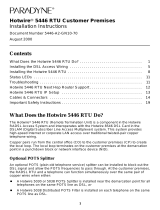 Paradyne Hotwire 5446 Specification
Paradyne Hotwire 5446 Specification
-
 Paradyne Hotwire 5446 User manual
Paradyne Hotwire 5446 User manual
-
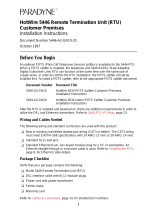 Paradyne Hotwire 5446 Installation Instructions Manual
Paradyne Hotwire 5446 Installation Instructions Manual
-
Paradyne COMSPHERE 3900 Series Installation guide
-
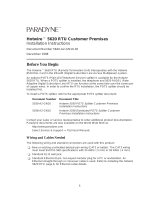 Paradyne Hotwire 5620 RTU User manual
Paradyne Hotwire 5620 RTU User manual
-
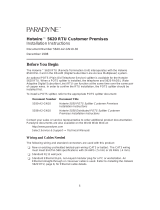 Paradyne Hotwire 5620 RTU User manual
Paradyne Hotwire 5620 RTU User manual
-
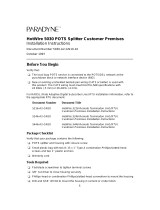 Paradyne 5030 Installation Instructions Manual
Paradyne 5030 Installation Instructions Manual
-
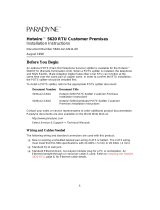 Paradyne Hotwire 5620 Installation Instructions Manual
Paradyne Hotwire 5620 Installation Instructions Manual
-
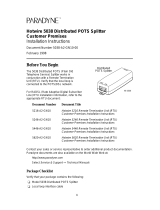 Paradyne 5038-A1-00 User manual
Paradyne 5038-A1-00 User manual
-
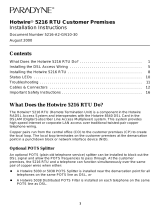 Paradyne Hotwire 5216 RTU Installation Instructions Manual
Paradyne Hotwire 5216 RTU Installation Instructions Manual
Other documents
-
Cables Direct BT-720 Datasheet
-
AT&T Paradyne COMSPHERE 3900 Series Installation guide
-
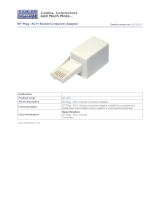 Cables Direct BT-700 Datasheet
Cables Direct BT-700 Datasheet
-
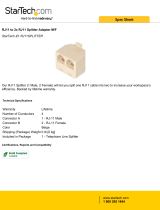 StarTech.com RJ11SPLITTER Datasheet
StarTech.com RJ11SPLITTER Datasheet
-
Hitachi CMP5000WXJ User manual
-
Century NSP-3 / NSP-3A Dry Cell Battery Owner's manual
-
Valueline VLTP90995W Datasheet
-
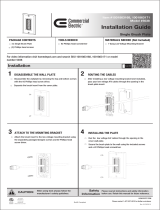 Commercial Electric 5038-WH Operating instructions
Commercial Electric 5038-WH Operating instructions
-
Raco AlarmAgent.com AA-102DC Installation guide
-
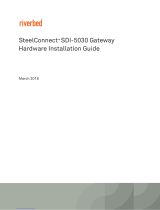 Riverbed SteelConnect SDI-5030 Hardware Installation Manual
Riverbed SteelConnect SDI-5030 Hardware Installation Manual



































